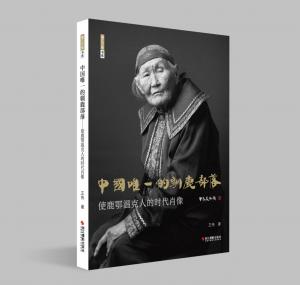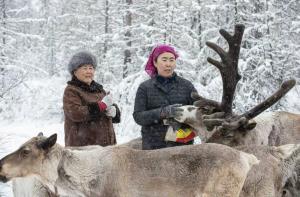The Only Reindeer-herding Tribe in China — Bringing Ewenki Reindeer Culture to the World
The Only Reindeer-herding Tribe in China — A Timeless Portrait of the Reindeer-Ewenki People: Bringing Ewenki Reindeer Culture to the World
NY, UNITED STATES, August 14, 2025 /EINPresswire.com/ -- Reindeer, the only deer species where both males and females grow antlers, are revered as "boats of the forest." The Ewenki reindeer herders of Genhe City, Inner Mongolia Autonomous Region, represent China's sole community that preserves intact reindeer herding traditions—a vital component of the broader circumpolar indigenous culture. China's Only Reindeer Tribe: A Portrait of the Ewenki Reindeer Herders, authored by Wang Wei and published by Zhejiang Photography Press, documents 34 Ewenki individuals through large-format photography and ethnographic narratives. The work traces their transition from forest-dwelling traditions to urban modernity, offering readers a window into this unique culture. Debuted at the 31st Beijing International Book Fair in June 2025, the book has drawn global attention. In this interview, the author reveals the story behind its creation.
(Q&A on the New Book)
Q: What inspired your decade-long documentation of the Ewenki reindeer herders?
A: In 2011, I was invited as a photographer to the Oroqen Autonomous Banner in Genhe City. The primal, mystical cultural essence embodied in the Ewenki people's reindeer-herding lifestyle deeply moved me, while many of the younger generation had already embraced modern life in the lowlands. My professional instinct told me this was a cultural paradigm urgently needing preservation, sparking my idea to use photography to document this precious heritage for future generations—thus beginning my "Oroqen Visual Odyssey."
Over 30 expeditions, I immersed myself in the reindeer herders' communities, adopting visual anthropology's ethnographic methods. I lived with them across seasons, capturing their contemporary portraits through a blend of artistic and documentary photography. In 2018, the project received funding from the National Arts Fund, accelerating its progress.
Q: What unique value does visual documentation hold for rapidly evolving cultures? Which details best reflect their cultural transition?
A: As a "living archive," photography preserves irreplaceable cultural codes: the precise pressure of an elder's fingertips on reindeer antlers, the depth of hoofprints during migrations, the muscle memory in birch-bark crafting. Only images can authentically conserve these nonverbal cultural carriers, providing visual evidence for anthropological research.
Simultaneously, visuals reveal "cultural crossroads"—the silent grief of hunters caressing rifles contrasted with youth live-streaming reindeer in Mandarin rather than Ewenki, or machine-embroidered traditional coats paired with sneakers. Such contrasts form a visual anthropology of survival strategies, integrating China's narrative into global indigenous preservation discourse as an Eastern case study for cultural continuity.
Q: Gaining local trust must have been challenging. How did you overcome communication barriers?
A: Having observed the Ewenki's weariness toward intrusive media during initial fieldwork, I prioritized relationship-building—sometimes waiting days before photographing. Establishing trust with elders proved foundational. Logistically, their "hunting camps" in the Greater Khingan Mountains' core presented extreme terrain without cellular service, adding technical difficulties.
Q: How do you balance objectivity with cultural intervention as a photographer?
A: Reindeer culture is dynamic—ecologically rooted yet constantly evolving. Through immersive observation, I strive to capture its authenticity while acknowledging photography's inherent subjectivity. My "objectivity" means rigorously representing observed realities through disciplined visual storytelling, yet consciously decentralizing my perspective to amplify Ewenki voices. Ultimately, I aim for my work to be a transparent window for global understanding.
Q: With both governmental and grassroots efforts promoting reindeer culture globally, what unique role can this book play?
A: Foreign audiences often exoticize reindeer cultures as static Arctic relics. This work deliberately highlights parallels between Ewenki and other circumpolar groups (Sámi, Nenets) in human-reindeer symbiosis and shared modern challenges—climate change, cultural adaptation. Such framing positions them within global indigenous networks, making their story universally relatable.
As sinologist Alexey Rodionov (Deputy Director, Oriental Studies at St. Petersburg State University) notes, the book lets "Ewenki wisdom shine uniquely under civilization's constellations." Through international exhibitions and media, I hope to showcase China's ethnic cultural brilliance in its full contemporary vitality.
China's reindeer culture is no exception—it demands examination through broader anthropological and contemporary lenses to reveal its value as a living, evolving tradition and to confront its modernization challenges, rather than being treated as a museum specimen.
This contextual approach helps international readers find points of connection and frameworks for understanding, bridging cultural gaps and enhancing the work's global appeal. As noted by sinologist Alexey Rodionov, Deputy Director of the Oriental Studies Department at Saint Petersburg State University, this book aims to "let the Ewenki people's stories and their ancient wisdom shine with unique brilliance under the constellation of world civilizations." It is my hope that the Ewenki reindeer culture can reach wider audiences through international exhibitions, publications, and media coverage, allowing the world to appreciate the vibrant diversity of China's ethnic minority cultures.
(Images courtesy of the interviewee)(Editors: Wang Lianxiang, Li Nanhua)
Xu Yandi
People's Daily Oversea Edition
email us here
Visit us on social media:
Other
Legal Disclaimer:
EIN Presswire provides this news content "as is" without warranty of any kind. We do not accept any responsibility or liability for the accuracy, content, images, videos, licenses, completeness, legality, or reliability of the information contained in this article. If you have any complaints or copyright issues related to this article, kindly contact the author above.



